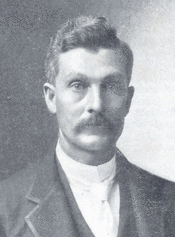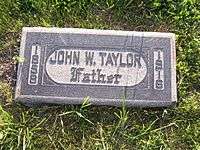John W. Taylor (Mormon)
John Whitaker Taylor (May 15, 1858 – October 10, 1916) was a member of the Quorum of the Twelve Apostles of The Church of Jesus Christ of Latter-day Saints (LDS Church) and was the son of John Taylor, the third president of the church. While he was an apostle, Taylor was excommunicated from the LDS Church for opposing the church's abandonment of plural marriage. He was subsequently posthumously re-baptized in 1965.
| John W. Taylor | |
|---|---|
 | |
| Quorum of the Twelve Apostles | |
| May 15, 1884 – April 1905 | |
| End reason | Resigned from Quorum in opposition to church's stance against plural marriage |
| LDS Church Apostle | |
| May 15, 1884 – March 28, 1911[1] | |
| Reason | Death of Charles C. Rich |
| End reason | Excommunicated for opposition to church's stance against plural marriage |
| Reorganization at end of term | No apostles ordained[2] |
| Personal details | |
| Born | John Whittaker Taylor May 15, 1858 Provo, Utah Territory, United States |
| Died | October 10, 1916 (aged 58) Forest Dale, Utah, United States |
| Cause of death | Stomach cancer |
| Resting place | Salt Lake City Cemetery 40°46′37.92″N 111°51′28.8″W |
| Spouse(s) | 6 |
| Parents | John Taylor Sophia Whitaker |
Family and occupation
John W. Taylor was born in Provo, Utah Territory, while his parents John Taylor and Sophia Whitaker were taking shelter there, along with other church members, during the Utah War. He married May Leona Rich (daughter of John Taylor Rich and Agnes Young) on October 19, 1882, and moved to Cassia County, Idaho, to ranch. As a practitioner of plural marriage, Taylor later married Nellie Todd, Janet Maria Wooley, Eliza Roxie Welling, Rhoda Welling, and Ellen Georgina Sandberg. He also worked as a county clerk and a newspaper editor.
Taylor's son Samuel W. Taylor became his biographer and a prolific writer of fiction and non-fiction.
Church service and conflict
In the LDS Church, Taylor was ordained as a deacon around 1872 and as a teacher in 1874. He also served as missionary in the United States, Canada, and England. Taylor was asked to be an apostle and member of the Quorum of the Twelve Apostles of the church by his father. He was ordained on May 15, 1884, his 26th birthday.
Taylor was a staunch believer in the doctrine of plural marriage, and had six wives and 36 children. Although the church officially forbade the practice with the 1890 Manifesto, Taylor continued to privately marry additional wives and under pressure submitted his resignation from the Quorum of the Twelve on October 28, 1905.[3] Matthias F. Cowley also resigned from the Quorum at the same time over the plural marriage dispute.[3] The following February, Marriner W. Merrill died. In the April General Conference of 1906, the resignations of Cowley and Taylor were presented to and accepted by the general church membership.[3] As a result, three new apostles were called to replace them and Merrill: George F. Richards, Orson F. Whitney, and David O. McKay.
Taylor disputed with the Quorum of the Twelve often after his resignation. He was finally excommunicated on March 28, 1911 for continued opposition to the Second Manifesto.[4][5] However, he remained a believer in Mormonism up to his death. He died of stomach cancer at his home in Forest Dale, Salt Lake County, Utah, at age 58.[6] He was buried at Salt Lake City Cemetery.
In August 1916, Taylor was posthumously baptized by proxy and reinstated into the church by two stake presidents. However, a year later, the First Presidency officially stated that the reinstatement was null and void. He was later officially rebaptized and on May 21, 1965, received the ordinance of Restoration of Blessings by proxy under the hands of Joseph Fielding Smith, President of the Quorum of the Twelve Apostles, with the unanimous approval of the First Presidency and Quorum of the Twelve Apostles.[7][8][9]
Honors
The Taylor Stake of the LDS Church, which was headquartered in Raymond, Alberta, was named in Taylor's honor. As an apostle, Taylor had made considerable efforts to assist the Mormon settlers in Canada. The Taylor Stake was renamed the Raymond Alberta Stake in the 1970s.
In the 2000s, the town of Raymond built a street named Taylor Street in his honor. An LDS Church chapel was built on the street, and it is named the Taylor Street Chapel.

See also
Notes
- Taylor resigned from the Quorum of the Twelve Apostles in April 1905; however, he remained an ordained apostle of the church until his excommunication in 1911.
- Since Taylor had been removed from the Quorum of the Twelve in 1905, his excommunication occasioned no vacancy in the Quorum of the Twelve.
- Thomas G. Alexander, Mormonism in Transition: A History of the Latter-day Saints, 1890–1930 (Urbana: University of Illinois Press, 1986) pp. 65–66.
- Victor W. Jorgensen & B. Carmon Hardy, "The Taylor–Cowley Affair and the Watershed of Mormon History", Utah Historical Quarterly 48:4 (1980).
- "Disciplining the Rebellious". Salt Lake Tribune. May 13, 1911. p. 6. Retrieved June 15, 2015.
- State of Utah Death Certificate Archived 2011-07-18 at the Wayback Machine.
- Deseret News Church Almanac
- Samuel W. Taylor (1974, rev. ed.). Family Kingdom (Salt Lake City, Utah: Western Epics).
- Jerry H. Houck, Witnesses of Christ: Prophets and Apostles of Our Dispensation (Springville, Utah: Cedar Fort, 2015) s.v. "John W. Taylor".
References
- Terrence C. Smith and Reed Turner (eds.) (2001). A Planting of the Lord : A Century of the Latter-day Saints in Raymond, 1901–2001 (Raymond, Alberta: Raymond Alberta Stake) ISBN 0-9689691-0-0
- Samuel W. Taylor (1971). Family Kingdom (Salt Lake City, Utah: Zion Book Store) ISBN 0-914740-14-8
- Jenson, Andrew (1901). Latter-day Saint biographical encyclopedia: A compilation of biographical sketches of prominent men and women in the Church of Jesus Christ of Latter-Day Saints. 1. Salt Lake City, Utah: The Andrew Jenson History Company (Printed by The Deseret News Press). pp. 151–156. Retrieved August 18, 2014.
- Jenson, Andrew (1920). Latter-day Saint biographical encyclopedia: A compilation of biographical sketches of prominent men and women in the Church of Jesus Christ of Latter-Day Saints. 3. Salt Lake City, Utah: The Andrew Jenson History Company (Arrow Press). pp. 789–790. Retrieved August 18, 2014.
External links
![]()
| Religious titles | ||
|---|---|---|
| Preceded by Heber J. Grant |
Quorum of the Twelve Apostles May 15, 1884 – April 1905 |
Succeeded by Marriner W. Merrill |